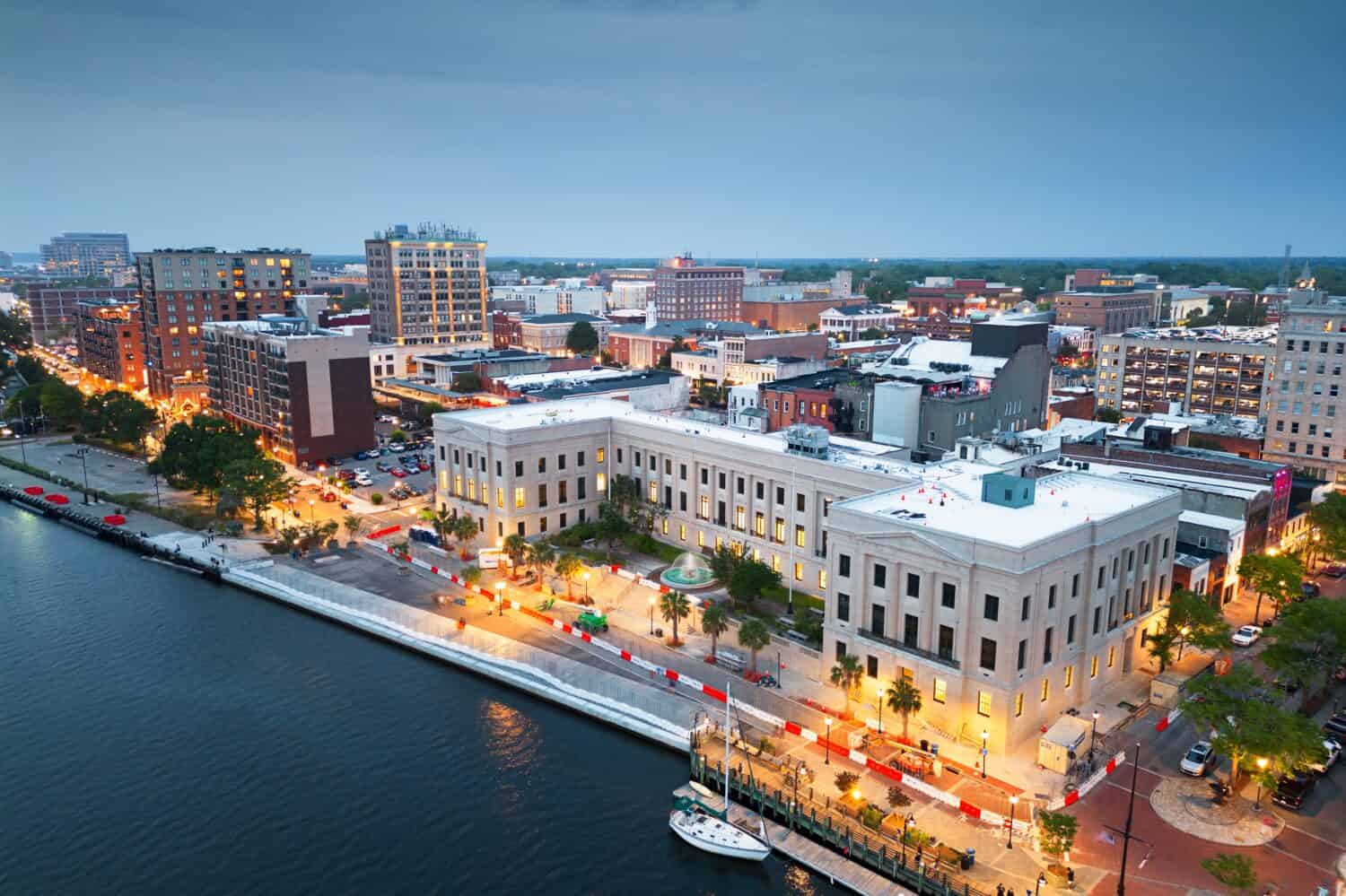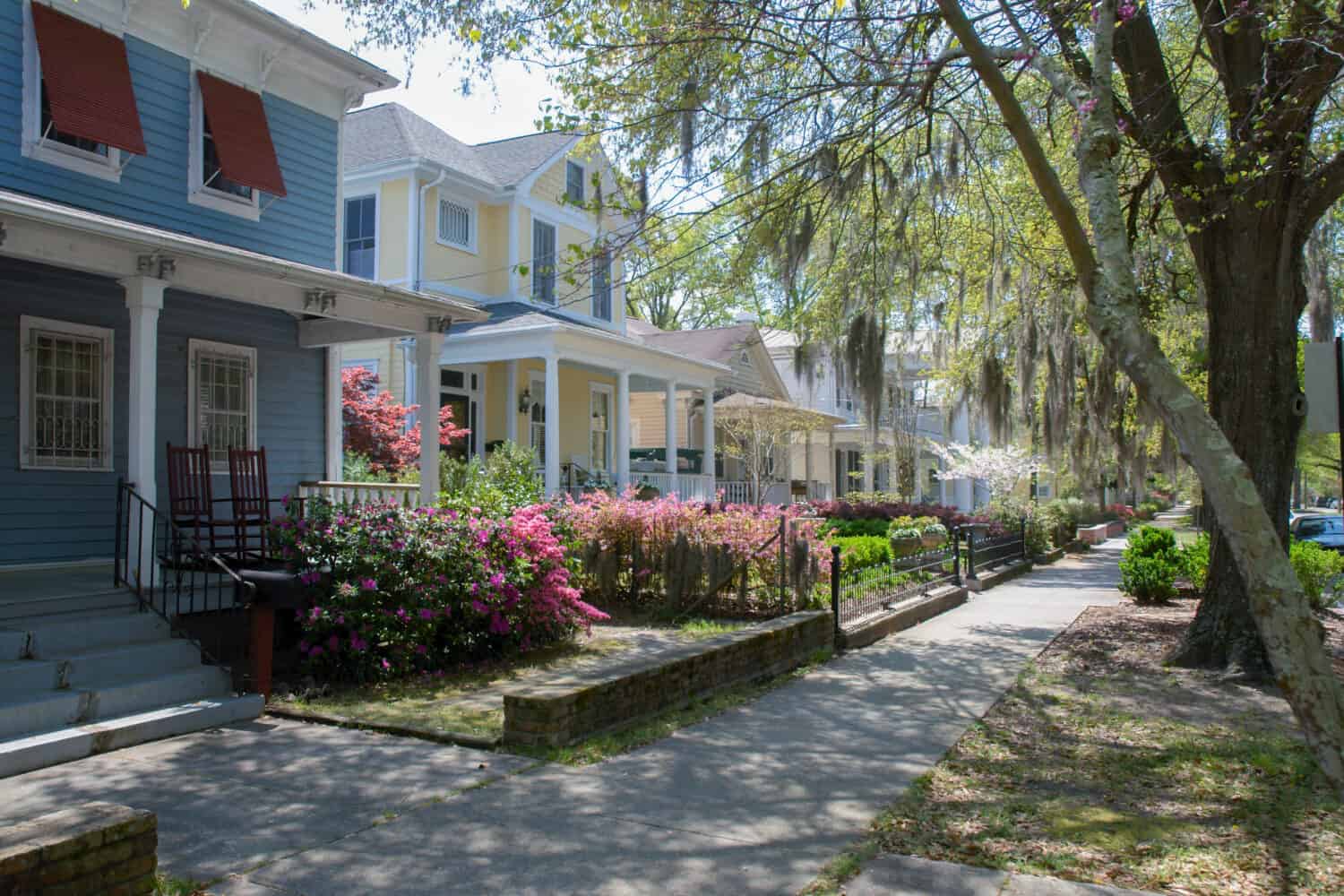One of the original Thirteen Colonies, North Carolina has a long and rich history. The Tarheel State gets its name from the Latin word for Charles (Carolus), after King Charles II of England in honor of the king’s act of granting land in North Carolina to early English settlers in the 17th century. Over the next few hundred years, Europeans and other settlers spread across the state, developing towns and cities. Several of the major metropolitan areas across the state, such as Charlotte and Raleigh, now support thriving populations and economies.
If you ever visit North Carolina, one of the first things you’ll notice is the heat and humidity. North Carolina has warm, wet summers and mild winters. Its warm, wet summers stem from water vapor traveling inland from the Gulf of Mexico and the Atlantic Ocean. This makes the air hot and moist, particularly during the summer months, from June to September. That said, what city or town ranks as the hottest place in North Carolina?
The hottest spot in North Carolina is Wilmington, a port city and the seat of New Hanover County.
The Hottest Spot in North Carolina

Wilmington is the hottest spot in North Carolina.
©Sean Pavone/Shutterstock.com
Wilmington is located in southeastern North Carolina. It lies between the Cape Fear River and the Atlantic Ocean on the Cape Fear peninsula. Nearby beach cities include Carolina Beach, Fort Fisher, Kure Beach, and Wrightsville Beach. Wilmington belongs to the Wilmington, NC, Metropolitan Statistical Area, which also includes adjacent New Hanover and Pender counties. The city has a population of 115,451 as of the 2020 census, while the metro area has a total population of 285,905.
Wilmington averages the hottest temperatures in the state of North Carolina. It boasts a daily mean temperature of 64.4 degrees Fahrenheit. Winters in Wilmington are relatively mild, with highs in the mid-50s and lows in the mid-30s (Fahrenheit) in January. Meanwhile, summer brings high humidity and temperatures in the high 90s or low 90s. On average, Wilmington experiences around 43 days with temperatures above 90 degrees per year. The highest temperature ever recorded in Wilmington was 104 degrees Fahrenheit on June 27, 1952.
Wilmington is the hottest spot in the state but doesn’t hold the record of the hottest temperature ever recorded in North Carolina. That honor belongs to Fayetteville, which recorded a temperature of 110 degrees Fahrenheit on August 21, 1983. Moreover, Fayetteville typically experiences hotter summers than Wilmington but also colder winters. As a result, Wilmington possesses the highest average temperature in the state.
History of Wilmington

Wilmington was founded in 1730.
©PatGallery/Shutterstock.com
Founded in 1730, Wilmington gets its name from the 1st Earl of Wilmington, Spencer Compton. Prior to European settlement, various Native American tribes lived in the area of contemporary Wilmington, such as the Eastern Siouan. As a major port city, the city played a prominent role during the American Revolutionary War. The city grew rapidly during the early and mid-19th century thanks to the construction of railroads between Wilmington and Weldon. Steamboats ran between Wilmington and Charleston, ferrying goods and passengers, further contributing to the city’s growth.
Prior to the Civil War, Wilmington possessed a mostly Black population. After North Carolina joined the Confederacy, Wilmington turned into a major port for Confederate blockade runners. The city fell to Union forces in February 1865 after the Battle of Wilmington. After the Civil War, Wilmington became a hub for Black businesses, and Black politicians, police officers, clerks, and superintendents abounded throughout the city. During the Reconstruction era, Wilmington grew into the largest and most economically prosperous city in North Carolina.
However, the city’s history took a sharp turn in 1898. That year, the Wilmington Insurrection witnessed a group of White Democrats lead a coup against Wilmington’s elected city government. This group wished to reestablish white supremacy in the city and to reduce the voting power of Blacks.
A group of around 1,500 White men overthrew the elected government and burned down the only Black newspaper in the city. In total, around 10 to 100 Blacks died during the attack, and over 2,100 Blacks left the city. Black political power and businesses remained repressed in the city until after the Voting Rights Act of 1965.
Where is Wilmington Located on a Map?
Wilmington is a small port city located in North Carolina. Additionally, the city is a gateway to Cape Fear Coast beaches such as Wrightsville. This beautiful area is known for its strong surf and stunning boardwalks.
Here it is on a map:
Things to Do in Wilmington

Wilmington hosts the Azalea Festival each year.
©PatGallery/Shutterstock.com
Despite its turbulent past, many of Wilmington’s historic places have managed to survive until this day. As a result, you can find numerous historic buildings across the city. Its historic downtown features a 1.75-mile riverwalk, which is considered one of the best riverfronts in the country.
Wilmington supports a thriving arts scene thanks to the presence of numerous theaters, museums, and performing arts centers in the city. Thalian Hall hosts hundreds of events annually, or you can check out a show put on by the University of North Carolina at Wilmington College of Arts and Sciences. Wilmington also serves as the home of EUE/Screen Gems Studio, the largest film studio located outside of California in the United States. The city hosts an independent film festival each year known as Cucalorus. Since 1948, the city has also sponsored the North Carolina Azalea Festival, the largest flower festival in the state.
Wilmington provides visitors with plenty to see and do during their stay. History buffs will enjoy touring the World War II battleship North Carolina or taking a trip to the For Fisher State Historic Site. If you like lying on the beach, you’ll love visiting one of Wilmington’s three nearby beaches: Carolina Beach, Kure Beach, and Wrightsville Beach. Alternatively, you could take a stroll through the Airlie Gardens or visit some of the shops and restaurants along the Carolina Beach Boardwalk.
Wildlife Around Wilmington

You can find diverse wildlife around Wilmington, such as the hawksbill turtle.
©John Back/Shutterstock.com
Wilmington lies on Cape Fear, which supports a diverse array of local wildlife. The cape’s mix of freshwater and saltwater habitats, riparian zones, forests, and wetlands serve as homes to a wide variety of animals.
In the Cape Fear River, you can find freshwater fish species such as walleye, largemouth bass, and Cape Fear shiner, a type of minnow. In the estuaries off the coastline live saltwater fish like black sea bass, bluefish, and black drum. Meanwhile, in the Atlantic Ocean just off Wilmington’s beaches, you can find fish such as marlin, barracuda, tuna, mackerel, and sea bass.
Around Wilmington, you can find turtles such as hawksbill and sea turtles as well as alligators and skinks. Wilmington is also home to venomous snakes like the copperhead, eastern diamondback rattlesnake, and cottonmouth, as well as nonvenomous snakes like the eastern hognose snake, scarlet snake, and various water snakes.
If you enjoy bird watching, then Wilmington offers plenty of chances for you to catch a glimpse of a wide variety of birds. In fact, nearly 14 sections of Cape Fear are classified as important bird areas by the Cape Fear Audubon Society. Birds that you can see around Cape Fear include great blue herons, white ibis, royal tern, yellow-rumped warblers, and red-headed woodpeckers.
Lastly, Wilmington is also home to various mammal species both within and without the city limits. Commonly sighted mammals include raccoons, rabbits, deer, opossums, and skunks. Meanwhile, you can find river otters as well as manatees in the waters around Cape Fear.
The photo featured at the top of this post is © Red Lemon/Shutterstock.com
Thank you for reading! Have some feedback for us? Contact the AZ Animals editorial team.







